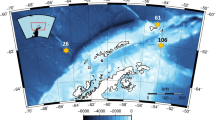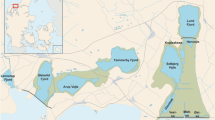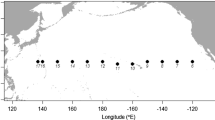Abstract
We measured grazing by herbivorous zooplankton (<200 μm fraction) in coastal and slope regions of the South Brazil Bight. Using the dilution technique, we performed nine experiments during the austral summer, when nutrient-rich South Atlantic Central Water is present on the shelf, and five during winter. These experiments provide the first estimates of microzooplankton grazing in the western South Atlantic Ocean. Model II regression showed a strong relationship between phytoplankton intrinsic growth rates and grazing, with a slope of 0.64 (±0.28; 95% confidence interval) indicating that microzooplankton grazing could account for the majority of phytoplankton mortality. Both phytoplankton growth and microzooplankton grazing were higher during the summer upwelling season, compared to winter. For the two experiments that were conducted in oligotrophic slope water, grazing accounted for >80% of phytoplankton production. A comparison of incubations with and without added inorganic nutrients showed no consistent stimulation of phytoplankton growth (slope of enriched versus unenriched treatments not significantly different from 1). Estimates from microscopic counts of heterotrophic organisms >10 μm indicated that copepod nauplii comprised the largest share of the microzooplankton biomass (mean 62.4 ± 5.8% SE). Grazing estimates were not correlated with microzooplankton biomass, whether or not nauplii were included, suggesting that most of the grazing was done by nano-sized zooplankton.







Similar content being viewed by others
References
Alldredge, A. L. & C. C. Gotschalk, 1989. Direct observations of the mass flocculation of diatom blooms: characteristics, settling velocities and formation of diatom aggregates. Deep-Sea Res. 36: 159–171.
Bakun, A., 1993. The California Current, Benguela Current, and Southwestern Atlantic Shelf Ecosystems: a comparative approach to identifying factors regulating biomass yields. In Sherman K., L. M. Alexander, B. D. Gold (eds), Large Marine Ecosystems: Stress, Mitigation, and Sustainability. AAAS Press, Washington, DC, 199–221.
Bakun, A. & R. H. Parrish, 1990. Comparative studies of coastal pelagic fish reproductive habitats: the Brazilian sardine (Sardinella aurita). Journal du Conseil 46: 269–283.
Calbet, A. & M. R. Landry, 2004. Phytoplankton growth, microzooplankton grazing, and carbon cycling in marine systems. Limnology and Oceanography 49: 51–57.
Campos, E., J. Goncalves & Y. Ikeda, 1995. Water mass characteristics and geostrophic circulation in the South Brazil Bight: summer of 1991. Journal of Geophysical Research 100: 18537–18550.
Castro, B. M. & L. B. D. Miranda, 1998. Physical oceanography of the western Atlantic continental shelf located between 4° N and 34° S. In Robinson A. R., K. H. Brink (eds), The Sea: the Global Coastal Ocean. John Wiley and Sons, New York, 209–251.
Crocker, K. & C. Gotschalk, 1997. Short communication. A simple seawater-powered plankton wheel. Journal of Plankton Research 19: 155–158.
Dagg, M., 1995. Copepod grazing and the fate of phytoplankton in the northern Gulf of Mexico. Continental Shelf Research 15: 1303–1317.
Dolan, J. R., C. L. Gallegos & A. Moigis, 2000. Dilution effects on microzooplankton in dilution grazing experiments. Marine Ecology-Progress Series 200: 127–139.
FAO, 2003. FAO Yearbook of Fishery Statistics. FAO, Rome.
Fileman, E. & P. Burkill, 2001. The herbivorous impact of microzooplankton during two short-term Lagrangian experiments off the NW coast of Galicia in summer 1998. Progress in Oceanography 51: 361–383.
Fileman, E. S., D. G. Cummings & C. A. Llewllyn, 2002. Microplankton community structure and the impact of microzooplankton grazing during an Emiliania huxleyi bloom, off the Devon coast. Journal of the Marine Biological Association of the United Kingdom 82: 359–368.
Froneman, P. W. & C. D. McQuaid, 1997. Preliminary investigation of the ecological role of microzooplankton in the Kariega Estuary, South Africa. Estuarine Coastal and Shelf Science 45: 689–695.
Froneman, P. W. & R. Perissinoto, 1996a. Microzooplankton grazing and protozooplankton community structure in the South Atlantic sector of the Southern Ocean. Deep-Sea Research Part I 43: 703–721.
Froneman, P. W. & R. Perissinoto, 1996b. Structure and grazing of the microzooplankton communities of the Subtropical Convergence and a warm-core eddy in the Atlantic sector of the Southern Ocean. Marine Ecology-Progress Series 135: 237–245.
Garcia-Pamanes, J. & J. R. Lara-Lara, 2001. Microzooplankton grazing in the Gulf of California. Ciencias Marinas 27: 73–90.
Gifford, D. J., 1988. Impact of grazing by microzooplankton in the Northwest arm of Halifax Harbour, Nova Scotia. Marine Ecology-Progress Series 47: 249–258.
Gifford, D. J., L. M. Fessenden, P. R. Garrahan & E. Martin, 1995. Grazing by Microzooplankton and Mesozooplankton in the High-Latitude North-Atlantic Ocean – Spring Versus Summer Dynamics. Journal of Geophysical Research-Oceans 100: 6665–6675.
Gonzalez-Rodriguez, E., 1994. Yearly variation in primary productivity of marine phytoplankton from Cabo Frio (RJ, Brazil) region. Hydrobiologia 294: 145–156.
Gonzalez-Rodriguez, E., J. L. Valentin, D. L. Andre & S. A. Jacob, 1992. Upwelling and downwelling at Cabo Frio (Brazil): comparison of biomass and primary production responses. Journal of Plankton Research 14: 289–306.
Gustafson, D. E., D. K. Stoecker, M. D. Johnson, W. F. Van Heukelem & K. Sneider, 2000. Cryptophyte algae are robbed of their organelles by the marine ciliate Mesodinium rubrum. Nature 405: 1049–1052.
Kamiyama, T., 1995. Change in the microzooplankton community during decay of a Heterosigma akashiwo bloom. Journal of Oceanography 51: 279–287.
Landry, M. & A. Calbet, 2004. Reality check on microbial food web interactions in dilution experiments: responses to the comments of Dolan and McKeon. Ocean Science Discussions 1: 65–76.
Landry, M. R., 1993. Estimating rates of growth and grazing mortality of phytoplankton by the dilution method. In Kemp P. F., B. F. Sherr, E. B. Sherr, J. J. Cole (eds), Handbook of Methods in Aquatic Microbial Ecology. Lewis Publishers, Ann Arbor: 715–722.
Landry, M. R., S. L. Brown, L. Campbell, J. Constantinou & H. B. Liu, 1998. Spatial patterns in phytoplankton growth and microzooplankton grazing in the Arabian Sea during monsoon forcing. Deep-Sea Research Part II-Topical Studies in Oceanography 45: 2353–2368.
Landry, M. R. & R. P. Hassett, 1982. Estimating the grazing impact of marine microzooplankton. Marine Biology 67: 283–288.
Liu, H. B., K. Suzuki & T. Saino, 2002. Phytoplankton growth, and microzooplankton grazing in the subarctic Pacific Ocean and the Bering Sea during summer 1999. Deep-Sea Research Part I-Oceanographic Research Papers 49: 363–375.
Longhurst, A. & D. Pauly, 1987. Ecology of Tropical Oceans. Academic Press, San Diego.
Matsuura, Y., 1996. A probable cause of recruitment failure of the Brazilian sardine, Sardinella aurita, population during the 1974/75 spawning seasons. South African Journal of Marine Science 17: 29–35.
Mauchline, J., 1998. The Biology of Calanoid Copepods. Academic Press, New York.
Nagasaki, K., M. Ando, I. Imai, S. Itakura & Y. Ishida, 1994a. Virus-like particles in Heterosigma akashiwo (Rhaphidophyceae): a possible red tide disintegration mechanism. Marine Biology 119: 307–312.
Nagasaki, K., M. Ando, S. Itakura, I. Imai & Y. Ishida, 1994b. Viral mortality in the final stage of Heterosigma akashiwo (Raphidophyceae) red tide. Journal of Plankton Research 16: 1595–1599.
Obayashi, Y. & E. Tanoue, 2002. Growth and mortality rates of phytoplankton in the northwestern North Pacific estimated by the dilution method and HPLC pigment analysis. Journal of Experimental Marine Biology and Ecology 280: 33–52.
Olson, M. B. & S. L. Strom, 2002. Phytoplankton growth, microzooplankton herbivory and community structure in the southeast Bering Sea: insight into the formation and temporal persistence of an Emiliania huxleyi bloom. Deep-Sea Research Part II-Topical Studies in Oceanography 49: 5969–5990.
Ouzounov, D., A. Savtchenko, G. Leptoukh, B. Zhou, D. Ostrenga, C. Deroo & L. Gonzalez, 2004. GES DAAC tools for accessing Terra and Aqua MODIS data. Pages 1109–1113 in Climate Change Processes in the Stratosphere, Earth-Atmosphere-Ocean Systems, and Oceanographic Processes from Satellite Data.
Parsons, T. R., Y. Maita & C. M. Lalli, 1984. A manual of chemical and biological methods for seawater analysis. Pergamon, New York.
Putt, M. & D. K. Stoecker, 1989. An experimentally determined carbon:volume ratio for marine “oligotrichous” ciliates from estuarine and coastal waters. Limnology and Oceanography 34: 1097–1103.
Ryther, J. H., 1967. Occurrence of red water off Peru. Nature 214: 1318–1319.
Sieracki, M. E., P. G. Verity & D. K. Stoecker, 1993. Plankton community response to sequential silicate and nitrate depletion during the 1989 North Atlantic spring bloom. Deep-Sea Research Part II 40: 213–225.
Smetacek, V. S., 1985. Role of sinking in diatom life-history cycles: ecological, evolutionary and geological significance. Marine Biology 84: 239–251.
Sokal, R. R. & F. J. Rohlf, 1995. Biometry, 3rd edn. W.H. Freeman and Company, New York.
Stoecker, D. K., 1999. Mixotrophy among dinoflagellates. Journal of Eukaryotic Microbiology 46: 397–401.
Strickland, J. D. & T. R. Parsons, 1972. A Practical Handbook of Seawater Analysis. Fisheries Research Board of Canada.
Strom, S. & M. Strom, 1996. Microzooplankton growth, grazing & community structure in the northern Gulf of Mexico. Marine Ecology-Progress Series 130: 229–240.
Uye, S. I, 1991. Temperature-dependent development and growth of the planktonic copepod Paracalanus sp. in the laboratory. Bulletin of Plankton Society, Japan Special Volume: 627–636.
Valentin, J. L., D. L. Andre & S. A. Jacob, 1987. Hydrobiology in the Cabo Frio (Brazil) upwelling: two-dimensional structure and variability during a wind cycle. Continental Shelf Research 7: 77–88.
Verity, P. G., & C. Langdon, 1984. Relationships between lorica volume, carbon, nitrogen, and ATP content of tintinnids in Narragansett Bay. Journal of Plankton Research 6: 859–868.
Acknowledgements
We thank G. Fernandes de Oliveira, M. Pompeu, M. Oliveira, T. Edison da Silva, S. Colin, A. Smith, S. Haley, W. Carvalho, Dr. E. Gonzalez-Rodriguez, the Brazilian Navy, IEAPM, and the Captain and crew of the RV Prof. W. Besnard. This research was supported by the US National Science Foundation (Office of International Programs: INT 0086659), the National Research Council of Brazil (CNPq; Office of International Cooperation Programs 910092/00-1, and PRONEX-CNPq 66.2368/1996-7, DEPROAS project; grants 477737/03 and 308055/2004-7 to RML), and the University of Connecticut.
Author information
Authors and Affiliations
Corresponding author
Additional information
Handling editor: S. Wellekens
Electronic supplementary material
Rights and permissions
About this article
Cite this article
McManus, G.B., Costas, B.A., Dam, H.G. et al. Microzooplankton grazing of phytoplankton in a tropical upwelling region. Hydrobiologia 575, 69–81 (2007). https://doi.org/10.1007/s10750-006-0279-9
Received:
Revised:
Accepted:
Published:
Issue Date:
DOI: https://doi.org/10.1007/s10750-006-0279-9




